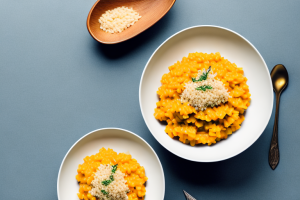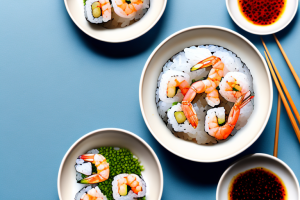How to prepare basmati rice with spicy chicken tikka
7 min read
A plate of basmati rice with spicy chicken tikka
If you’re in the mood for a flavorful and aromatic meal, then you might want to try making basmati rice with spicy chicken tikka. The combination of tender chicken pieces and fragrant, fluffy rice will definitely satisfy your taste buds. But before we dive into the recipe, let’s learn more about basmati rice and its nutritional benefits.
The origin of basmati rice and its nutritional value
Basmati rice is a type of long-grain rice that originated from the Indian subcontinent. It has a distinct aroma and flavor that sets it apart from other types of rice. Basmati rice is also rich in nutrients such as vitamins B and E, minerals like iron and zinc, and dietary fiber. With its low glycemic index, basmati rice can help regulate blood sugar levels and promote healthy digestion.
Aside from its nutritional benefits, basmati rice is also a popular choice for its versatility in cooking. It can be used in a variety of dishes, from savory curries to sweet rice puddings. Basmati rice is also a staple in many cultures, including Indian, Pakistani, and Middle Eastern cuisine. In fact, it is often served during special occasions and celebrations. Its popularity has even led to the creation of different varieties, such as brown basmati rice and aged basmati rice, each with their own unique characteristics and flavors.
Different types of basmati rice and which one to choose for your recipe
There are different types of basmati rice available in the market, each with its own characteristics and cooking times. The most common ones include white, brown, and aged basmati rice. White basmati rice is the most popular choice, and it has a delicate flavor and fluffy texture when cooked. Brown basmati rice is a healthier option, and it has a nutty flavor and chewy texture. Aged basmati rice is more expensive and has a stronger aroma and flavor. For this recipe, it’s best to use white basmati rice as it pairs well with the spices in chicken tikka.
It’s important to note that the quality of basmati rice can vary greatly depending on where it’s grown and how it’s processed. Look for rice that has a long, slender grain and a subtle fragrance. Some popular brands include Tilda, Royal, and Daawat. When cooking basmati rice, it’s important to rinse it thoroughly before cooking to remove excess starch and prevent clumping. Additionally, soaking the rice for 30 minutes before cooking can help it cook more evenly and result in a fluffier texture.
How to properly wash and soak basmati rice
Before cooking basmati rice, it’s important to wash it thoroughly to remove any dirt or impurities. Rinse the rice in a fine-mesh strainer under running water until the water runs clear. Then, soak the rice in water for about 20-30 minutes to allow the grains to absorb moisture and cook evenly.
It’s important to note that the amount of water used for soaking the rice should be twice the amount of rice. For example, if you’re soaking one cup of rice, use two cups of water. This will ensure that the rice is fully hydrated and cooks evenly.
After soaking the rice, drain the water and add fresh water for cooking. The ratio of water to rice for cooking basmati rice is typically 1.5 cups of water for every cup of rice. Bring the water to a boil, then reduce the heat to low and cover the pot. Allow the rice to simmer for about 18-20 minutes, or until all the water has been absorbed and the rice is tender.
The importance of choosing high-quality chicken for chicken tikka
When making chicken tikka, the quality of the chicken meat is crucial for achieving the right texture and flavor. Choose high-quality chicken breast or thigh meat from a trusted source, and make sure it’s fresh and free from any visible signs of spoilage.
Additionally, it’s important to consider the welfare of the chickens when choosing your meat. Look for labels indicating that the chickens were raised in humane conditions and were not given antibiotics or hormones.
Another factor to consider is the environmental impact of the chicken production. Choosing meat from farms that prioritize sustainable and eco-friendly practices can help reduce the carbon footprint of your meal.
Tips on marinating and seasoning chicken tikka for maximum flavor
To add flavor and tenderness to the chicken, marinate it in a mixture of yogurt and spices such as cumin, coriander, turmeric, and paprika. The yogurt helps to tenderize the meat and adds a creamy texture to the dish. You can also add grated ginger, minced garlic, and lemon juice for a bright, citrusy flavor. Don’t forget to season the marinade with salt and black pepper to taste.
For an extra kick of heat, you can also add chili powder or cayenne pepper to the marinade. If you prefer a milder flavor, you can reduce the amount of spices or omit the chili altogether. It’s important to let the chicken marinate for at least 2 hours, but preferably overnight, to allow the flavors to fully penetrate the meat.
When it comes to cooking the chicken tikka, you can grill it on skewers or bake it in the oven. If grilling, make sure to preheat the grill and oil the grates to prevent sticking. If baking, place the chicken on a wire rack over a baking sheet to allow air to circulate and ensure even cooking. Serve the chicken tikka with naan bread, rice, and a side of raita for a delicious and satisfying meal.
Grilling vs. baking: which cooking method is best for chicken tikka?
Traditionally, chicken tikka is cooked over a hot charcoal grill or tandoor oven, which gives it a smoky flavor and crispy exterior. However, you can also bake it in the oven for a healthier and easier option. To grill the chicken, thread the marinated pieces onto skewers and grill them over medium-high heat until charred and cooked through. To bake the chicken, arrange the marinated pieces on a baking sheet and roast them in the oven at 400 F for 15-20 minutes, or until golden brown and fully cooked.
While grilling and baking are both popular methods for cooking chicken tikka, each has its own advantages and disadvantages. Grilling is a great option if you want a smoky flavor and crispy texture, but it requires more attention and can be difficult to control the temperature. On the other hand, baking is a more hands-off approach that allows you to cook large batches of chicken tikka at once, but it may not have the same level of flavor and texture as grilled chicken.
If you want to combine the benefits of both methods, you can try a hybrid approach by grilling the chicken tikka for a few minutes to get the charred flavor and then finishing it off in the oven to ensure it’s fully cooked. Another option is to use a grill pan on the stovetop, which can give you the grilled flavor without the need for an outdoor grill.
How to ensure your chicken tikka is cooked to perfection
To ensure that your chicken tikka is cooked evenly and to the right temperature, use a meat thermometer to check the internal temperature of the thickest part of the meat. The temperature should reach 165 F for chicken to be fully cooked. If you’re grilling the chicken, use tongs to turn the skewers regularly to prevent burning. If you’re baking the chicken, rotate the baking sheet halfway through cooking to ensure even browning.
Another important tip to ensure your chicken tikka is cooked to perfection is to marinate the chicken for at least 2 hours before cooking. This will not only add flavor but also help tenderize the meat. You can use a store-bought marinade or make your own using yogurt, spices, and lemon juice. Additionally, make sure to let the chicken rest for a few minutes after cooking to allow the juices to redistribute and keep the meat moist.
Creating the perfect spicy sauce to complement your basmati rice and chicken tikka
For a spicy and creamy sauce to go with your rice and chicken, mix together some yogurt, tomato paste, curry powder, red pepper flakes, and a pinch of sugar. Adjust the amount of spice to your liking, and add a splash of water if the sauce is too thick. You can also sprinkle some chopped fresh cilantro or mint on top for added freshness and flavor.
If you want to add some tanginess to your sauce, you can also squeeze in some lemon juice or add a tablespoon of vinegar. This will give your sauce a zesty kick that will complement the flavors of the chicken and rice. Additionally, if you prefer a smoother texture, you can blend the sauce in a food processor or blender until it reaches your desired consistency.
For a vegan version of this sauce, you can substitute the yogurt with coconut cream or cashew cream. This will give your sauce a rich and creamy texture without the use of dairy. You can also experiment with different spices and herbs to create your own unique flavor profile. Some options include cumin, coriander, turmeric, and ginger.
Serving suggestions for a complete meal with basmati rice and chicken tikka
When your basmati rice and chicken tikka are ready, serve them hot alongside the spicy sauce and some naan bread or pita bread. You can also add some grilled veggies such as bell peppers, onions, and zucchini for extra color and nutrition. Don’t forget to garnish with some fresh herbs and lemon wedges for a pop of brightness. Enjoy your flavorful and healthy meal!
If you want to add some more protein to your meal, you can also serve it with a side of lentil soup or chickpea curry. These dishes complement the flavors of the basmati rice and chicken tikka and provide a well-rounded meal. Additionally, you can pair your meal with a refreshing cucumber and mint raita or a tangy mango chutney for some added flavor. Experiment with different combinations to find your perfect meal!


